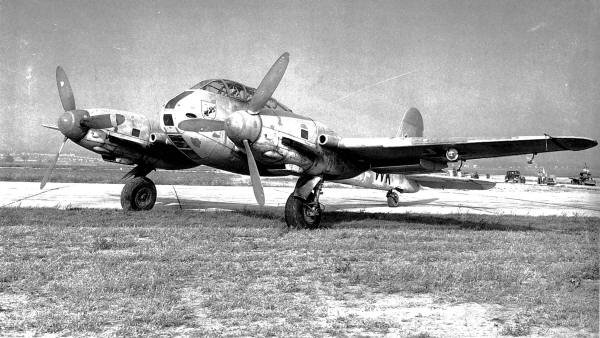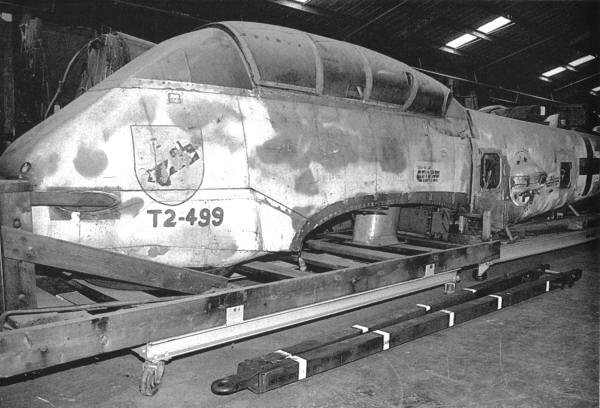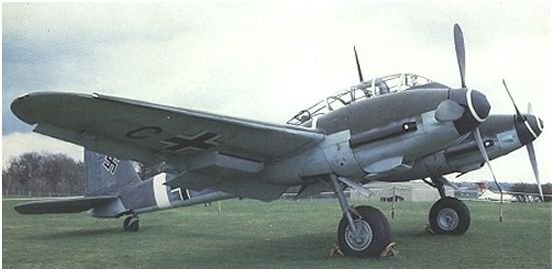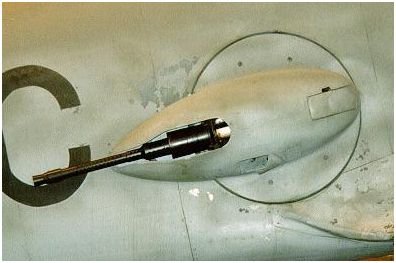|
Me
410A-2/U1 FE-499 W Nr 10018  Powered by FreeWebsiteTranslation |
|
|
|
|
 at Wright Field P. M. Bowers |
|
 in 'deep storage' at Silver Hill Alan Curry collection |
|
| Source | Disposition |
|
War Prizes pg 217 |
Found in undamaged condition at Trapani, Sicily, in August 1943, its capture being recorded in RAF AI.2(g) Intelligence Report No. 204 of 12 August. |
| Luftwaffe Over Ohio! | Shipped to the US in 1944 |
|
War Prizes pg 217 |
Was at Wright Field by 7 October 1944. |
|
War Prizes pg 217 |
Recorded at Freeman Field on 17 May 1946 |
|
War Prizes pg 217 |
Recorded at Freeman Field on 1 August 1946 |
|
War Prizes pg 217 |
Now with the National Air and Space Museum in storage at Silver Hill, Maryland. |
|
Specifications (Messerschmitt Me 410A-1/U2
Hornisse "Hornet") Variants: Me 210/V1, Me 210/V3, Me 210/V4-V10, Me 210/V13, Me 210A-0, Me 210A-1, Me 210A1/U1, Me 210A-2, Me 210B, Me 210C-1a, Me 210C-1/C-2, Me 210D-1/D-1a , Me 210E-1, Me 210F-1, Me 410A-1 (light bomber), Me 410A-1/U1 (photo-reconnaissnce), Me 410A-1/U2 (heavy fighter), Me 410A-1/U4 (specialized bomber/destroyer - included a 50 mm BK 5 gun mounted below the fuselage), Me 410A-2 (heavy fighter), Me 410A-2/U1 (similiar to the Me 410A-1/U1), Me 410A-2/U2 (radar equipped night fighter), Me 410A-2/U4 (bomber/destroyer), Me 410A-3 (reconnaissance aircraft equipped with three cameras), Me 410B-1/B-2 (improved "A" series), Me 410B-3 (reconnaissance version similiar to the Me 410A-3), Me 410B-5 (torpedo and anti-shipping varient that was in the test stage when the war ended), Me 410B-6 (a specialized anti-shipping variant, built in small numbers, which was equipped with FuG 200 Hohentwiel search radar, and had an armament comprising of two 20 mm MG 151/20 cannon, two 30 mm MK 103 cannon and two 13 mm (0.51 in) MG 151 machine guns. Avionics: SN-2 Lichtenstein Radar on Me
410A-2/U-2 Night Fighter, FuG 200 Hohentwiel ASV (air/surface vessel)
Radar on Me 410B-6 Anti-Shipping variant. Operators: Germany (Luftwaffe), Hungary.
Background The original design of the Me 210 was born
in late 1937 to overcome to some shortcomings of the Bf 110. In autumn
1938 RLM awarded a contract to Arado and Messerschmitt simultaneously for
the development of a Bf 110 replacement. The resulting Messerschmitt
design consisted in a mere improvement of the basic design with more
powerful powerplants and heavier armament. Arado’s answer to the
requirements was the Ar 240 but confidence in the original Bf 110
long-range fighter and bomber-destroyer concept led at the beginning of
1938 to Messerschmitt being asked to design an eventual successor. The
result was the Messerschmitt Me 210 which first flew on 5 September 1939,
powered by two 1,050 hp (783 kW) Daimler-Benz DB 601A engines. It proved
to be extremely unsatisfactory, being difficult to handle and suffering
from extreme instability. Such were the problems encountered that eight pre-production Me 210A-O and 13 production Me 210A-l aircraft were added to the test program, but in spite of this very little improvement was evident, and it was obvious that only major design changes would have any chance of correcting the faults. At this stage such a move would have caused an unacceptable delay in the production program, so deliveries began and 64 were supplied starting in April 1941 in two variants, the Me 210A-l destroyer-bomber which was armed with two 20 mm MG 151/20 cannon and two 7.92 mm (0.31 in) MG 17 machine guns, and the Me 210A-2 fighter-bomber which had a maximum bombload of 4,4091b (2000 kg). By the end of 1941 the test program was over and the final evaluation was that it was still an unsuitable firing platform for its stability problems. Messerschmitt modified a pre-production plane (Me 210 A-0 NE+BH Werk Nr. 101) with lengthened rear fuselage (lengthened by 1½ panels) and redesignating it with the Versuch-number V17 on 14 March 1942. This modification was very successful in increasing the plane’s handling qualities. Another important modification was the fitting, in July 1942, of wing leading edge slots. Soon after flying tests it was ordered to retrofit all Me 210 As with this device. However, on 14 April 1942, after about 200 Me 210s had been delivered (this number including two Me 210B-0 pre-production and two Me 210B-l production reconnaissance aircraft), construction was halted in favour of a resumption of manufacture of the Bf 110 to give time to try to resolve some of the Me 210's shortcomings. The stability problem was solved finally by introducing automatic wing leading-edge slots and redesign of the rear fuselage, which was lengthened by 3 ft 1 1/2 in (0.95 m) and made deeper. The improvements were tested and the design was submitted with the proposal that the 1,750 hp (1305 kW) Daimler-Benz DB 6O3A engine should be used to provide better performance, This appealed to the RLM, as a solution of this kind would allow a number of unfinished Me 210 airframes to be used, and Messerschmitt was given the go-ahead and the designation 410 assigned to the revised design. Before describing the Me 410, mention should be made of the Me 210C, a version of the earlier model which was built in Hungary by the Danube Aircraft Factory. Messerschmitt had supplied jigs and tools, and a new factory had been built for production when the German decision to stop its own Me 210 program was made. The Hungarians nevertheless decided to proceed and one of the pre-production Me 210A-0s had been fitted with 1,475 hp (1100 kW) DB 605E engines as a prototype for the Me 210C. The engines were license-built by Manfred Weiss. The Me 210C had the wing slots and new rear fuselage, and production deliveries from the Hungarian factory started at the beginning of 1943. They were split on the basis of one-third to the Royal Hungarian air force and two-thirds to the Luftwaffe. Production was slow to develop, but by early 1944 the first Hungarian units had been formed. Production ended in Hungary in March 1944, by which time 267 Me 210Cs had been built in two variants, the Me 210C-1 reconnaissance/bomber-destroyer aircraft, and the Me 21OCa-1 bomber-destroyer/dive-bomber. In contrast with the Luftwaffe, Hungarian pilots liked the Me 210 and used it as a close-support aircraft and dive-bomber. The Me 410 "Hornisse" The Me 410 prototype was a converted Me
210A-0, and several other Me 210As were generally brought Up to Me 410
standard but with DE 601F engines. Improvements in handling
characteristics made the Me 410 far more acceptable to the Luftwaffe which
received the first five Me 410A-1 light bombers in 1943, this version
being armed with two 20 mm MG 151/20 cannon, two 7.92 mm (0.31 in) MG 17
machine guns, and two 13 mm (0.51 in) MG 131 machine guns mounted one each
side of the fuselage in an electrically powered barbette. Maximum internal
bombload was 4,409 lbs (2000 kg). Demand for these more effective aircraft
built up rapidly with the result that Messerschmitt's Augsburg production
line was supplemented by a second line When Dornier entered the program in
early 1944. As Me 410A production expanded a number of sub-variants
entered service, including the photo-reconnaissance Me 410A-1/U1, Me
410A-1/U2 heavy fighter and the Me 410A-1/U4 specialized bomber-destroyer,
its armament including a 50 mm BK 5 gun mounted beneath the fuselage. The
Me 410A-1 was followed into service by the Me 410A-2 heavy fighter
included two 30 mm MK 108 cannon in its armament, also built in
sub-variants, including the Me 410A-2/U2 which was similar to the Me
410A-1/U1, the Me A-2/U2 radar carrying night-fighter and an ME 410A-2/U4
bomber destroyer similar to the Me 410 A-1/U4, and the last of the A
series, the Me 410A-3 reconnaissance aircraft equipped with three cameras.
A very important innovation in the Me 210 design was the use of side rear firing 13 mm (0.51 in) MG 131 turret guns (barbettes) controlled by the rear crew member by the means of a Revi gun sight and a pistol grip with the firing trigger. These barbettes were delicate maintenance pieces and were not easy to handle. A famous victim of these guns was the American Ace Captain James Morris of the 20th Group. On 7 July 1944, over Halle and Bernburg, he was shot down and killed in his P-38 Lightning by an attacked Me 410. In April 1944 the first of the improved E-series were delivered, introducing the 1,900 hp (1417 kW) DE 603G engine, and produced in Me 410E-1 and Me 410E-2 sub-variants that were basically similar to those of the A-series. The Me 410E-3 was a reconnaissance version similar to the Me 410A-3, the Me 410E-5 a torpedo and anti-shipping bomber that was in the test stage when the war ended, and the Me 410E-6 a specialized anti-shipping variant, built in small numbers, which was equipped with FuG 200 Hohentwiel search radar, and had armament comprising two 20 mm Mg 151/20 cannon, two 3O mm MK 103 cannon, and two 13 mm (0.51 in) MG 131 machine guns. Other projects failed to materialize. As the Allies stepped up the daylight bombing offensive in 1944 the Me 410s were engaged increasingly in home defense and accounted for a number of heavy bombers, although they also suffered heavily at the hands of the escorting fighters. Production was finally phased out in September 1944 after 1,160 Me 410s had been built, and although the type had not achieved the successes hoped for it had been a vast improvement on the disastrous Me 210. Projects wanted the Me 410 night fighter version, designated Me 410-D, to be equipped with Lichtenstein C-1 or SN-2 air intercept radar system, flame extinguishers for the exhaust pipes, and armed with four MK 108 30 mm high-speed cannons and two MG 151/20 mm cannons as bow armament as well as two MK 108 used as schräge Musik angled cannons. The outer wing surfaces were to be built in wood to conserve strategic materials. Unfortunately this configuration never saw service nor either transformed in factory according to records. Variants Me 210A/A-1/A-2 - The Me 210A was the production version built two variants. The Me 210A-1 was the bomber/bomber destroyer variant with the Me 210A-2 being the dive bomber/bomber destroyer variant. Me 210C - A version produced by the Danube Aircraft Factory in Hungary from jigs and tooling supplied by Messerschmitt. This version incorporated leading edge slats and the redesigned rear fuselage of the Me 410 and powered by a version of the Daimler-Benz 1,475 hp (1100 kW) DB 605B engine built under license by Manfred Weiss. Production totaled 267 aircraft, with a third going to the Hungarian air force and the balance to the Luftwaffe. Me 310 - A proposed high altitude fighter of which development was abandoned. Me 410A/A-1/A-2/A-3 - Initial production version built in three variants. The Me 410A-1 was a high speed bomber, the Me 410A-2 destroyer and the Me 410A-3 reconnaissance version plus sub-variants. Me 410B/B-1/B-2/B-3 - These were basically similar to the Me 410A/A-1/A-2/A-3 in construction and roles but all were equipped with the more powerful Daimler-Benz 1,900 hp (1417 kW) DB 605G engine. Me 410B-5/B-6/B-7/B-8 - The Me 410/B-5 was an anti-shipping/torpedo variant, the Me 410B-6 anti-shipping variant, Me 410B-7 day reconnaissance variant and the Me 410B-8 night reconnaissance. These four sub-variants were in the test flight/prototype stage and all were to equipped with the Daimler-Benz 1,900 hp (1417 kW) DB 605G engine. |
|
 |
|

